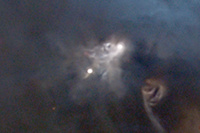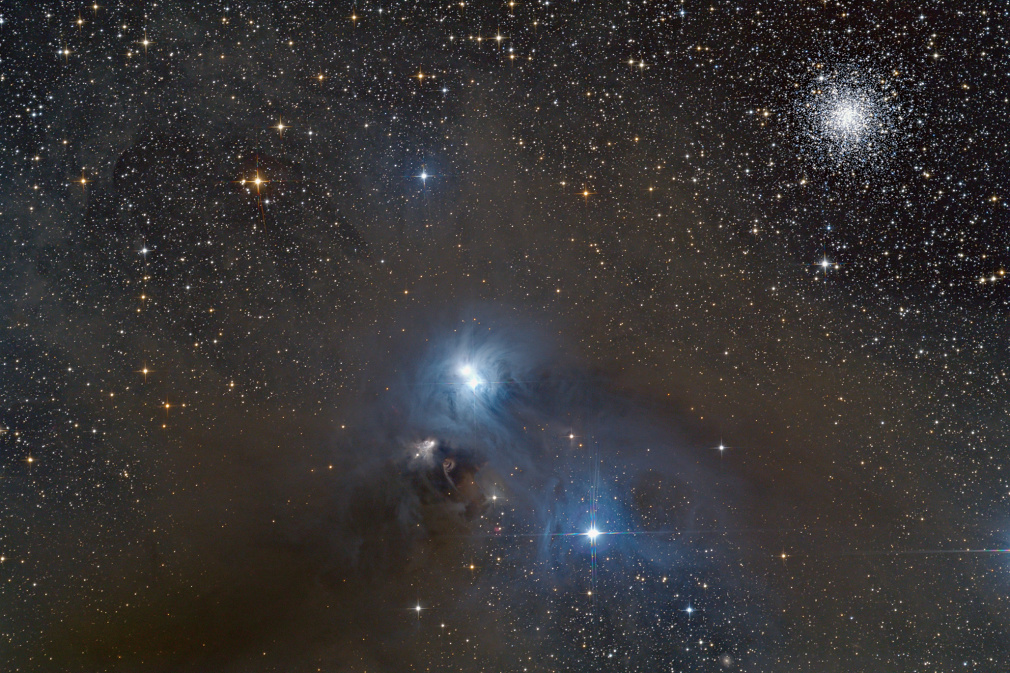Corona Australis Cloud Complex
Different parts of the complex appear in various ways in the picture. The dark brown parts are neither lit nor ionised by nearby stars, thus they appear dark and are visible by concealing the objects behind. Blue shining parts of the nebula are being lit by young stars in the vicinity, reflecting the light of the star, as we pointed a blue lamp on dense dark fog. Even yellow light of older stars can be seen being reflected by the cloud in a few cases if we watch the image carefully.
Cosmic shadow play
 The reflection nebula around the two bright stars at the centre of the photo, and the fan-shaped nebula was discovered by Friedrich Julius Schmidt at Athens Observatory in 1861. The blue reflection nebula has two separate IDs in the NGC catalogue: NGC 6726 and NGC 6727, while the fan-shaped one got the number 6929. The fan is being lit by variable star R CrA. There are thick gas- and dust clouds orbiting the star, which absorb varying amount of the its light, thus we see the brightness of R CrA changing. As a side-effect, changing amount of light is reflected by the interstellar medium in the broader vicinity of the star too, as a result the fan also seems to change its brightness. The change is so rapid that it can be indicated within 24 hours. Actually we are looking at a cosmic shadow play: the shadow of the gases and dust orbiting the star is projected on the screen formed by the interstellar medium. The phenomenon is interesting and exciting, and fortunately it is not unique, so there are similar objects in the northern celestial hemisphere too. For example Hubble's Variable Nebula (NGC 2261) in the constellation of Monoceros, which was named after its famous discoverer.
The reflection nebula around the two bright stars at the centre of the photo, and the fan-shaped nebula was discovered by Friedrich Julius Schmidt at Athens Observatory in 1861. The blue reflection nebula has two separate IDs in the NGC catalogue: NGC 6726 and NGC 6727, while the fan-shaped one got the number 6929. The fan is being lit by variable star R CrA. There are thick gas- and dust clouds orbiting the star, which absorb varying amount of the its light, thus we see the brightness of R CrA changing. As a side-effect, changing amount of light is reflected by the interstellar medium in the broader vicinity of the star too, as a result the fan also seems to change its brightness. The change is so rapid that it can be indicated within 24 hours. Actually we are looking at a cosmic shadow play: the shadow of the gases and dust orbiting the star is projected on the screen formed by the interstellar medium. The phenomenon is interesting and exciting, and fortunately it is not unique, so there are similar objects in the northern celestial hemisphere too. For example Hubble's Variable Nebula (NGC 2261) in the constellation of Monoceros, which was named after its famous discoverer.
The Corona Australis Molecular Cloud Complex is one of the closest star forming regions of Milky Way. Several newly born stars are located inside of it, however most of them are still visible in infrared pictures only, because they haven't had enough time to blow away the remains of the dense cloud they are formed of with their stellar winds.
Herbig-Haro objects

 We can, however observe some of the stars formed at the closer edge of the molecular cloud. Some of them eject gases at high speeds, aligned to their rotational axis, focused into narrow jets. Remains of the cloud the star was formed of fall towards the star on a spiral orbit perpendicular to the star's rotational axis. Then -probably because of strong magnetic fields- they get ejected along the rotational axis in two narrow jets, at speed of several hundreds of kilometres per second. Gases in the jets slow down when they collide with the interstellar medium, and at the same time, their temperature increases. They become so hot that gas atoms get ionised, and start to emit light similar to emission nebulae. This kind of objects were first observed in the second half of 19th century, but at that time astronomers did not know how different they are from ordinary emission nebulae. Astronomers begin to understand their real nature only in the 1940s,
We can, however observe some of the stars formed at the closer edge of the molecular cloud. Some of them eject gases at high speeds, aligned to their rotational axis, focused into narrow jets. Remains of the cloud the star was formed of fall towards the star on a spiral orbit perpendicular to the star's rotational axis. Then -probably because of strong magnetic fields- they get ejected along the rotational axis in two narrow jets, at speed of several hundreds of kilometres per second. Gases in the jets slow down when they collide with the interstellar medium, and at the same time, their temperature increases. They become so hot that gas atoms get ionised, and start to emit light similar to emission nebulae. This kind of objects were first observed in the second half of 19th century, but at that time astronomers did not know how different they are from ordinary emission nebulae. Astronomers begin to understand their real nature only in the 1940s,  George Herbig and Guillermo Haro were the firsts who realised their importance and started to study them, and also the object type was named after them. There are more than 400 Herbig-Haro objects known today, and a few of them are also visible in the photo: HH 99 is appearing as small red dots above the eyes of the anteater, HH 100 is the one resembling a snail right next to the fan, and the red glowing HH 101 a bit below the snail.
George Herbig and Guillermo Haro were the firsts who realised their importance and started to study them, and also the object type was named after them. There are more than 400 Herbig-Haro objects known today, and a few of them are also visible in the photo: HH 99 is appearing as small red dots above the eyes of the anteater, HH 100 is the one resembling a snail right next to the fan, and the red glowing HH 101 a bit below the snail.
The anteater stays hungry
The molecular cloud complex and its different parts, including the young stars formed of it and the Herbig-Haro objects are at about the same distance, in 420 light-years, being one of the closest star forming regions in the Milky Way. The globular cluster in the upper right corner, which is composed of old stars, is a much farther farther object, its distance is about 28000 light-years, therefore the anteater has to crawl quite a distance to be able to eat from it...
